
Spiral Women 2003
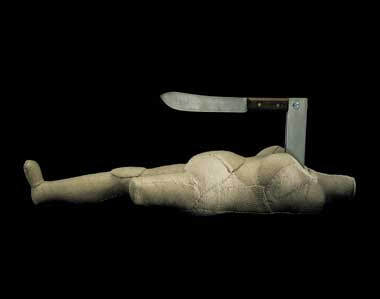
Femme Couteau 2002
Damien Hirst

For the Love of God
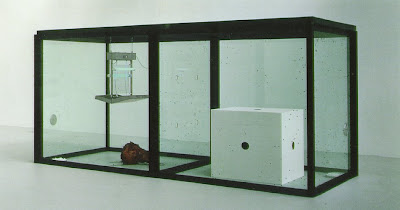
A Thousand Years
Janine Antoni

Slumber 1993
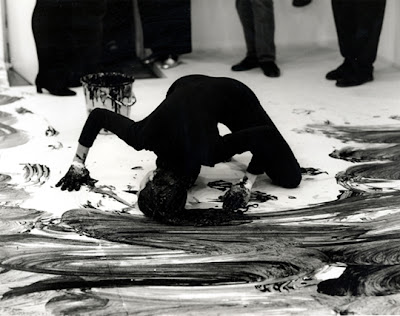
Loving Care 1993
Janine Antoni is an artist well known for her works of body art, particularly in the manner of translating everyday bodily activities such as eating sleeping and bathing into her art. Frequently using her body as a means to explore and provoke discussion about the relation of the body to the modern world. For instance, Gnaw involved making sculpture of lipstick and candy from pieces of lard and chocolate that she chewed out of enormous blocks, and obliterating a series of chocolate and soap busts by licking them/bathing herself with them. She does not consider her work to be performance art, but a method for arousing conflicting feelings in the viewer.
Anna Von Merten

As the stars go by (series)
As the Stars Go By, examines the star rotation patterns above violent moments in American history. The works have the proportions of a movie screen, intended as a representation of historical events through the removed lens of observation, but in this format also representing a literal vista, a window into a world.
Events depicted include September 11th, where as one looks from New York toward Boston the world seems to tilt around the north star in a vertiginous spin; the one-day Battle of Antietam during the Civil War, which remains the single day the most Americans have died; and the first sighting of land by Christopher Columbus off the coast of the Bahamas, where the stars are both a navigational tool and an indicator of the changes to come.
These events have produced a psychological shift, where time acts as a pivot point so that what came before and what follows seem part of different worlds. The pieces act on many levels: as a memorial, as an actual viewpoint from a specific moment in history, as a study of astrological forces. But ultimately it simply documents a natural cycle that is oblivious and impassive to the violence below.
In previous series the site of the bed is the primary context for her work. Displaying quilts as bed sculptures surfaces inherent meanings: the body, the home, a place of the familiar, a centering point.
Felix Gonzalez-Torres
Untitled
the interior space was important to the displaying of the work of electric light fixtures, jigsaw puzzles, paired mirrors, wall clocks and beaded curtains the intention to queer exhibition spaces in the most simple and poignant ways. His primary audience, as he explained in an interview was his lover, Ross (who died of AIDS 6 years before his own death in 1996). Yet his work clearly appeals to a large audience for its combination of formal restraint and emotional lushness. The theme of lovers combined with themes of mortality, loss and absence are always charged with the sensibility of an overtly queer man, his art nonetheless often passed under the radar of the self-appointed moral guardians in both the political and art worlds.
Felix Gonzalez-Torres was a not-so-secret agent, able to infiltrate main stream consciousness in a most beautiful and poetic way. Activist without being didactic, a catalyst of that rare combination of sensuality and political empathy, he raised the bar on future queer art making, and continues to be one of the most influential artist of his generation. the notion of gift giving the replenishing of the given away paper stacks and candies fascinates the art practice and suggests of how the audience interact with art for free, what does the viewer feel taking away the work, do they keep or eat the work, why do they take it, is it just because they can.
the Felix Gonzalez-Torres foundation were connected to see how the audience knew they were allowed to take away the art. through the response it came to light that they were advised through the gallery assistants or by simple text that read "please take one", it was with this notion that consciousness continued developed into a audience interactive piece.
Sabrina Gschwandter

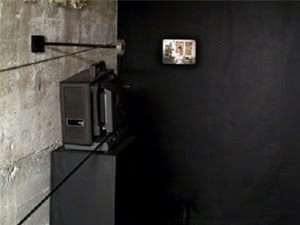
Annabel Nicholson
Nicholson's art is about the materials she uses, whether the physical materiality of canvas and the filmstrip or the immateriality of transient light and space in performance. Like a phantasmagoria's she employs minimal means to conjure the marvelous, from the film-loops she manipulated so idiosyncratically in her earliest expanded-cinema pieces to the later performances using voice, recorded sounds and small precarious sources of light to create intimate scenarios which simultaneously make metaphorical reference to the 'seeing in the dark' magic of cinema and the ancient tradition of fireside storytelling.
The aspect of the female association with textiles and the notion of film being a mans industry highlights how the two collide together, Nicholson's work has a great deal of intrigue to the performance is displays to the time based element of the film completely disintegrating during the duration of the performance .
Ann Wilson
The frame-by-frame hand construction of animation is very much like the structural development of lace - a structure that accumulates part by part over time through sequences of motions with the potential to replicate and expand infinitely. The hand processing of both the animation and the textile displays aspects of foible, imperfection, curiosity, and irregularly.
There are relationships between humor and darker aspects to the content in Errant Behaviors, evolving ideas about quirky growth, sometimes playful and sometimes sinister-seeming relationships, rude actions, repetitions and accumulations. The behaviors of Errant Behaviors have to do with aspects of impropriety, aggression and accident.
Shawn Decker's sound compositions utilize both processed recorded and found sounds to create environments of sonic activity which mirror the behavior of the visual images. The sound in some segments has a singular presence; other segments have a more cinematic presentation; some employ partially synchronized sound within a sonic environment. There is consideration throughout of the relationships between natural, human, and synthetic rhythms.
Susannah Strong

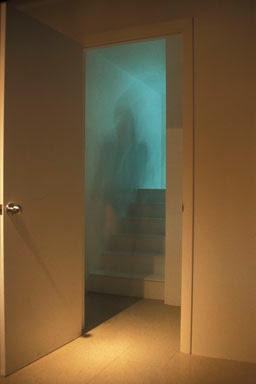
Glenys Hodgson
The artworks have an exploration of the 'gift' and the gift exchange as a complex nexus of generosity, sacrifice, power and excess. in modern society the gift and the act of giving and receiving gifts is perhaps the most potent means by which individuals attach to one another and unite as communities.
Intrigued by the conflicting ideas of self interest and altruism that operate within the world of the gift-giving - Particularly the motivation and attachment of individuals, makes gift-giving a powerful indicator of feelings and the creator of memories and personal histories.
Amy Houghton
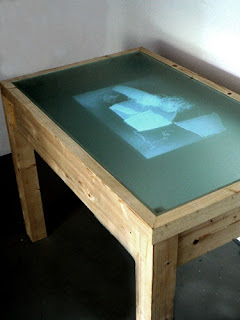
The resulting porcelain-fabric works are either installation pieces or framed in acrylic, on slate or on glass. Some works are backlit, taking advantage of the fine translucency of the porcelain.
Amy's concern has always been to express the beauty of things that are ordinarily not noticed and allows us to observe a snapshot of movement or change. Her work also explores the beauty and stories held in the memories linked to textiles and other objects in peoples' lives, and also within the textures of faces, hands, hair and eyes.
Materials and process also have a large influence on Amy's work and she is fascinated with exploring the manipulation possibilities of fabrics, and how this can be combined with other materials such as ceramics, metals and most recently photographic and digital imagery.
Susan Hiller
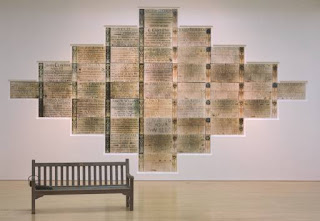
Christian Boltanski

Chohreh Feyzdjou

Reflecting ironically upon consumer society and the art market, she creates her own products out of cheap materials, which are then labeled with the trademark "Product of Chohreh Feyzdjou". They were generally kept in a kind of storage room (the "Boutique") and cataloged, just as her rolled-up or otherwise packed-up works from an earlier time, which she has, in this way, recycled and recontextualized. Everything is covered with black pigment, as if shrouded in darkness. Some boxes store simply a black mass.
Monika Weiss

Nina Saunders

Nina Saunders defamiliarise’s domestic objects to have an uncanny appearance the provokes a sense of unease in the viewers mind. Nina explains her work as something that could contain hidden things, growing, and bursting as if something has grown out of all proportion and isn’t quite right… it has some terrible, obstructive elements to it that is contained on the edge. I’ve spent a lot of time wondering if I could make fear visible, what would it look like. Nina’s work refers to the theories of Freud which were explored in “The Uncanny” in 1919. Within this Freud argued that the uncanny represents the reappearance of repressed material from childhood. The chair by Saunders plays opposites of beauty/revulsion, comfort/discomfort, homeliness/alienation, the swelling is like a symptom of something wrong.
Since the early nineties, Nina Saunders has conceived and produced works arising out of the subversion of the everyday object. Usually made from upholstery, her sculptures and installations form a kind of trompe-l'oeil representation of domestic reality. Saunders distorts utilitarian objects. She retrieves used furniture and transforms it with her radical interventions and invests them with incongruous functions with social or ideological import.
In the Softpan installation for Hygiene the ordinary implements used to clean domestic space become fetish objects. Her work addresses the routine obsessions of keeping spaces clean. Her work has been exhibited widely.
Andreas Serrano

Andreas Serrano wanted the images to portray the resemblance of the extended fingers of god barely touching, Serrano photographed people in a morgue who had died from various methods. he started his career by delivering highly abstracted and theatrical depictions on bodily fluids such as urine, semen, milk and blood which created pieces that were loaded with religious scientific and sociological significance. Serrano strives to present subjects in unexpected ways so that the audience will see them anew and recognise our habits of stereotyping the subjects by good and evil, high and low. His choice of religious subjects results from his conflicted view of his catholic upbringing.
Tatsuo Miyajima

Mega Death
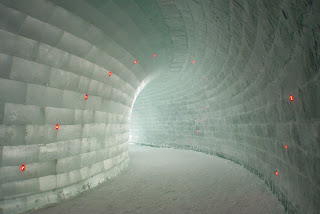
Ice Tunnel
Bill Viola

Nantes Triptych

The Passing
Bill Viola is considered a pioneer in the medium of video art and is internationally recognized as one of today’s leading artists. He has been instrumental in the establishment of video as a vital form of contemporary art, and in so doing has helped to greatly expand its scope in terms of technology, content, and historical reach. Viola’s video installations—total environments that envelop the viewer in image and sound—employ state-of-the-art technologies and are distinguished by their precision and direct simplicity. They are shown in museums and galleries worldwide and are found in many distinguished collections. His single channel videotapes have been widely broadcast and presented cinematically, while his writings have been extensively published, and translated for international readers. Viola uses video to explore the phenomena of sense perception as an avenue to self-knowledge. His works focus on universal human experiences—birth, death, the unfolding of consciousness—and have roots in both Eastern and Western art as well as spiritual traditions, including Zen Buddhism, Islamic Sufism, and Christian mysticism. Using the inner language of subjective thoughts and collective memories, his videos communicate to a wide audience, allowing viewers to experience the work directly, and in their own personal way.
the Passing by viola offered an intriguing experience into the avenue of someone else thoughts on the area of death and the experience they may undergo. the dark hazy black and white film created a process of insight into what i person may feel when dying this was beneficial as i become intrigued by the camara angelling and the way some scenes were as if i was looking through his eyes, seeeing the world from his perspective.
Rachel Whiteread

Airbed Series
Rachel Whiteread's sculptures are casts of carefully chosen objects, most of which bear the traces of human use. the Bed Casts can be associated with sleep, illness and dying.



